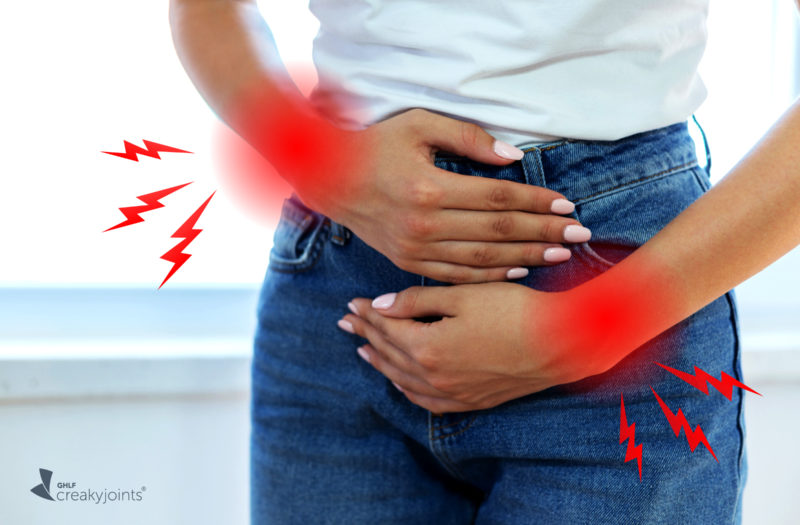Eileen Davidson doesn’t need a calendar to predict the start of her period. In the days leading up to it, she gets bloated, gassy, and ravenous for really bad foods. Her acne flares up, her mood becomes more irritable, and her sleep gets disrupted.
This PMS struggle is real for many women, but for Eileen, who is a patient advocate in the CreakyJoints community and lives with rheumatoid arthritis (RA), this time of the month feels extra tough.
“Night sweats set in about a week or so before, and get worse the closer to my period,” says Eileen, 34. When her sleep is poor, she’s more tired and sedentary during the day, which often exacerbates her rheumatoid arthritis pain.
“I also notice more inflammation in my hands and feet, and tend to run a mild fever,” explains Eileen, who was diagnosed with RA in 2015. “When my period arrives, the night sweats calm down, but the fever and fatigue continue.”
Eileen is not alone: In one study that included 267 members of the CreakyJoints community and its ArthritisPower patient research registry, nearly half of respondents (most of whom had RA) felt that their arthritis disease activity varied over the course of their menstrual cycle, with the worst flares occurring several days prior to or during menstruation.
“Anecdotally, many women note worsening of symptoms primarily during the week or so that is the premenstrual part of the cycle into the menses,” says Lisa R. Sammaritano, MD, a rheumatologist at Hospital for Special Surgery in New York City. But scientifically the link between menstrual cycles and inflammatory arthritis flares remains unclear.
How Your Menstrual Cycle May Affect Inflammatory Arthritis Flares
Experts agree that more research is needed, but there are some theories.
Fluctuating Hormone Levels
Research suggests that variations in hormone levels that occur during your menstrual cycle may influence arthritis disease activity and the severity of symptoms.
In the days leading up to and during your period, levels of the hormones estrogen and progesterone are low. One small study published in the journal Rheumatology found that women with RA reported increased pain, fatigue, and disease activity right before their period. Those with systemic lupus erythematosus (SLE) experienced similar symptom flares during menses.
After your period, estrogen levels rise, peaking right before ovulation (which occurs mid-cycle, when your ovaries release an egg). During ovulation, estrogen dips; then afterward, both estrogen and progesterone levels steadily increase as your body prepares for a potential pregnancy.
Women have reported that their inflammatory arthritis symptoms improve several days after and up to two weeks after their period. One study found morning stiffness was reduced in RA patients during the post-ovulatory phase, when these female hormones were high.
Toward the end of your menstrual cycle, if the egg isn’t fertilized and you’re not pregnant, both estrogen and progesterone plummet again — this is your premenstrual (PMS) week.
Women who are pregnant, however, have reported decreased disease activity during pregnancy — when estrogen hormones and progesterone levels remain high — and may experience flares postpartum, when those hormone levels decrease.
“It seems likely that hormones may impact disease activity directly, such as by promoting or alleviating inflammation,” says Dr. Sammaritano. They may have a systemic effect on the immune system, as well as within the joint.
Pain Perception
Another potential connection between flares in arthritis symptoms and your period is pain perception. When estrogen levels are low, women may report more pain, according to some research.
In one study of 20 women with chronic pain, researchers found rated pain significantly higher in the menstrual and premenstrual phases than in the mid-menstrual and ovulatory phases. “It may be that a change in pain threshold contributes to pain and fatigue during the premenstrual phase, in addition to a true increase in inflammation.” says Dr. Sammaritano.
Can Oral Contraceptive Pills Ease Arthritis Flares?
The jury is out on this, too: Some research suggests oral contraceptives pills (OCPs) may ease pain and improve function in women with RA. In one study from researchers in Iran, 100 women with rheumatoid arthritis were randomized to take birth control pills or a placebo for eight weeks. Researchers measured patients’ tender and swollen joints, blood levels of inflammation, and self-reports of pain at the beginning and end of the study period. They found that those on the birth control pills reported improvements in disease activity compared to those taking placebo pills.
Other studies have shown conflicting results. In the survey of CreakyJoints and ArthritisPower members with inflammatory arthritis, of those who used oral contraceptive pills, 70 percent of the women did not report changes, fewer than 10 percent reported improvement, and slightly more than 10 percent reported worsening of symptoms.
Talk to your rheumatologist to determine the risks and benefits and if OCPs are right for you.
How to Ease Arthritis Flares During Your Period
You know your when your body is going through PMS, and likely have some go-to strategies for helping to ease symptoms. If you get bloated, you cut back on salty foods and opt for elastic-waist sweatpants instead of jeans. If you get cranky, you might do a little more yoga to reduce stress.
If you suspect that your approaching period exacerbates arthritis symptoms, here are ways to help ease flares:
Follow your prescribed RA treatment plan
Keeping your RA disease activity under control will help reduce inflammation in your body. That’s one less factor possibly contributing to pain, mood swings, sleep disruption, and more.
Ask about pain medications
Nonsteroidal anti-inflammatory drugs (NSAIDs) — such as over-the-counter ibuprofen (Advil, Motrin IB, others) and naproxen sodium (Aleve) — can relieve pain and reduce inflammation. If you aren’t already taking these medications regularly for arthritis-related pain, says Dr. Sammaritano, your doctor may suggest adding it to your regimen the week before your period. Talk to your health care provider to see if this is appropriate and safe for you.
Remember that even over-the-counter NSAIDs can have side effects, such as stomach problems (pain, constipation, diarrhea, ulcers) and more. Make sure you follow dosing instructions and that your doctor knows about all the medications and supplements you take.
Track your symptoms
That’s what Eileen did to help her better understand her menstrual cycle and how it affected her overall health. “If you know exactly how RA symptoms get worse around your period, you can be a little more proactive,” says Nilanjana Bose, MD, MBA, a rheumatologist at the Rheumatology Center of Houston in Texas. For instance, maybe you take extra care to eat well or avoid other arthritis triggers, she says.
You can use our ArthritisPower app to track your symptoms and disease activity and share your results with your doctor.
Carve out time for gentle exercise
The benefit is twofold: Exercise not only helps ease PMS symptoms (such as mood changes and difficulty concentrating), but it can strengthen the muscles around your joints, improve flexibility, and fight fatigue.
“I do some gentle movement every hour to prevent stiffness and relieve pain,” says Davidson.
Apply heat or cold
A warm compress can help ease pain and stiffness, cold can help ease inflammatory symptoms, such as swelling. Try both to see which works best for you or alternate between the two. Here are simple ways to do hot therapy and cold therapy at home.
Give yourself a break
“My period can take so much out of me,” says Eileen. “It can feel like a daunting task trying to refresh myself.” But she allows her body the time it needs to rest and makes it a point during this time to be kind and gentle to herself. “I remind myself that this will pass,” she says.
Amini L, et al. Effect of oral contraceptive pills on rheumatoid arthritis disease activity in women: A randomized clinical trial. Medical Journal of The Islamic Republic of Iran. February 2018. doi: https://doi.org/10.14196/mjiri.32.61.
Colangelo K, et al. Self-reported flaring varies during the menstrual cycle in systemic lupus erythematosus compared with rheumatoid arthritis and fibromyalgia. Rheumatology. April 2011. doi: https://doi.org/10.1093/rheumatology/keq360.
Costenbader KH, et al. Do female hormones affect the onset or severity of rheumatoid arthritis? Arthritis Care & Research. March 2008. doi: https://doi.org/10.1002/art.23324.
Fernanda Romo-García M, et al. The Role of Estrogens in Rheumatoid Arthritis Physiopathology. Rheumatoid Arthritis: Other Perspectives towards a Better Practice. November 2020. doi: https://doi.org/10.5772/intechopen.93371.
Hellström B, et al. Pain perception across the menstrual cycle phases in women with chronic pain. Perceptual and Motor Skills. February 2003. doi: https://doi.org/10.2466/pms.2003.96.1.201.
Interview with Lisa R. Sammaritano, MD, a rheumatologist at Hospital for Special Surgery in New York City
Interview with Nilanjana Bose, MD, MBA, a rheumatologist at the Rheumatology Center of Houston in Texas
Latman NS. Relation of menstrual cycle phase to symptoms of rheumatoid arthritis. The American Journal of Medicine. June 1983. doi: https://doi.org/10.1016/0002-9343(83)90789-1.
Menstrual Cycle. Merck Manual Consumer Version. https://www.merckmanuals.com/home/women-s-health-issues/biology-of-the-female-reproductive-system/menstrual-cycle.
Menstrual Cycle. Office on Women’s Health. U.S. Department of Health & Human Services. https://www.womenshealth.gov/menstrual-cycle.
Rudge SR, et al. Menstrual cyclicity of finger joint size and grip strength in patients with rheumatoid arthritis. Annals of the Rheumatic Diseases. August 1983. Doi: http://dx.doi.org/10.1136/ard.42.4.425.
Talabi MB, et al. Pregnancy, Periods, and “The Pill”: Exploring the Reproductive Experiences of Women with Inflammatory Arthritis. ACR Open Rheumatology. April 2019. doi: https://doi.org/10.1002/acr2.1016.






